

|
Home Updates Hydros Cars Engines Contacts Links Contact On The Wire |
‘The West Country Wizard’
|
|
The tethered hydroplane world is remarkable in the number of participants who have had the urge to ‘get a bit more involved’. The list is extensive, but goes back at least to George Lutz who raced hydroplanes on the Welsh Harp in the 1920s. Later Lionel French, British B class record holder with ‘Little Star’, turned to racing motorcycles alongside his fellow hydroplane enthusiast W.H. Megean. In more modern times John DeMott and John Hyder could also be found howling round circuits on bikes, while John’s late brother Ken made a name for himself in karting. Stu Robinson had many years of car racing before he turned to the tethered variety, but it is largely through hydroplane racing that OTW came into being. Power-boating featured strongly in the ‘alternative’ careers of several competitors, including Steve Poyser in circuit powerboats, Frank Jutton who became Class III powerboat champion and Hugh Blowers who ran 250 and 350cc hydroplanes for several years. |
One person stands out though, and that is the late John Rose, who started racing with tethered hydroplanes, became a champion several times over in outboard hydros, and then returned for another highly successful stint with the tethered boats. What is even more remarkable is that this was achieved in each case with engines that he had designed and built entirely from scratch.
Starting Out
John Rose was born in Coventry in 1930, and after education at the local technical school, went as an engineering trainee at the Morris factory, working in the machine shop. Around 1948 he became involved with the Coventry MES where Bill Churcher, who had started racing tethered hydroplanes in 1939, was also a member, registration CV1. Bill raced a series of 15cc four-stroke boats called ‘Annette’, the last of which is happily still in existence. It was probably this association that prompted John to build what would be the first of his many engines, and start running tethered boats. The motor he built was a single cylinder, 15cc four-stroke, with inclined overhead valves, very similar to Churcher’s pre-war version and based on Westbury’s Kittiwake design. Although both had the carburettor on the right and the exhaust on the left, Bill’s took the drive from the timing side of the engine while John’s had the cam box and pushrods to the front of the boat.
|
The first hull that John used was a simple scow with aluminium side planes which was capable of nearly 40 mph. Running as CV6, he first came to prominence at the Grand Regatta in 1951, although he may well have been running before this. In his report, ‘Meridian’ (John Benson) mentions that, ‘a new competitor, J. Rose managed to secure 3rd place at 38mph with a nice-looking 15cc. Four-stroke engined boat’, behind George Lines’ two-stroke ‘Sparky’ and Frank Jutton’s flash steam ‘Vesta 2’. Visits to regattas would have indicated to John that his hull design was somewhat out of date and so over the winter he built a very smooth streamlined hull, with outrigger sponsons and a surface prop. This new boat was called ‘Meteor I’, not to be confused with Colin Stanworth from Bournville who also named his boats ‘Meteor’. |
|
|
|
The same four-stroke motor was used, but very quickly, the new hull proved its worth with several notable performances during the 1952 season. John Benson was to write that "An outstanding feature of the racing was the two-stroke versus four-stroke duel provided by the Class ‘B’ boats, Sparky II by George Lines and Meteor I by John Rose. Lines was one of the leading ‘B’ class competitors, but John was challenging him all season with the new boat. At the International he finished second to Lines with his fastest speed so far of 49.1 mph. He was to better this at Longholme Lake, Bedford where he took first place, with a run at over 50 mph. At the Wicksteed regatta in August John won the Patten cup at 44.8mph beating Bert Stalham, and adding to the places he had won ‘at several events recently’. The high point of the year was a run at 58.2mph at Southampton, which not only beat George Lines and ‘Sparky’, but also was the fastest speed so far recorded by a ‘B’ class, four-stroke motor. |
1953 was to see some major changes for John Rose, starting early in the year when he married Catherine ‘Marion’ Nassau in Coventry. He also became a member of the Bristol Club, moving down from Coventry to work for Bristol Cars, a post war offshoot of the Bristol Aircraft Company. He had moved to Bristol Cars because at that time they were involved in racing around Europe and at Le Mans, and being involved in this appealed to him immensely.
|
Soon after he arrived however, the racing section was disbanded and around 1955 he became foreman of the workshop. He remained at Bristol Cars for over twenty years, becoming one of the chief designers and also doing some of the test-driving. Few regatta reports mention John during the 1953
season, probably due to the move and change in jobs, but he did meet up with his
old foe George Lines at Wicksteed again, finishing 2nd to him in the
Patten Cup. |
|
In the 1953 season review, published in January 1954, it was noted that John had been using a brew of methanol and nitro-benzene in his motor and had abandoned spark ignition in favour of glow plugs. These changes did not seem to affect the speed of the boat, but made starting the motor much easier. The 1954 season passed by without a mention in any reports, but things then become a little confused as John appeared with a ‘new Bristol boat’ at Bournville in 1955, which was called ‘Mayfly’. Still a 15cc four-stroke, it made a successful debut by taking 3rd place at 39.18 mph. By a strange coincidence the exactly same speed in 1956 secured 2nd place in the Collier Trophy, again at Bournville, but this time with ‘Meteor 3’. Again, no details of this boat or engine are recorded. A more significant event in 1956 was the arrival of John and Marion’s first son David, conveniently born just before the regatta season got under way.
|
The Bristol Club was rooted in the principle of homebuilt engines with the likes of George Noble having built flash steam and IC engines in a variety of sizes and cylinder configurations. Commercial motors were dominating 10cc racing, which led to the class being subdivided into ‘C Restricted’ for the Doolings, McCoys, Hornets etc and ‘C’ for the home built motors. Several competitors were producing home built copies of the American motors, but true to the traditions of the Club, John used the Westbury Ensign design as the basis for his first foray into this class. At the first Bristol regatta at its new lake at Coalpit Heath in 1957, the boat "Performed well and showed what one can do with a moderately ported engine." 49.9 mph gained him second place to Dickie Phillips’ ‘FOZ 2’, the British record holder. Right: John with 'C' class hydro. 10cc motor built to Westbury design. |
|
|
|
The Ensign based motor was never going to equal the performance of the American look-alike that Phillips had built as this had exceeded 76 mph two years previously. John persevered with this aged design and ‘achieved his best ever regatta performance with a speed of 57.46 mph’ in 1958, which was much closer to Dickie Phillips’ winning run of 65.56 mph. The report in Model Engineer also shows John running the late George Noble’s twin cylinder hydroplane. Left. Preparing to launch the twin. |
|
With a few exceptions, including Mr Churcher who was still campaigning the veteran ‘Annette’, the four-stroke was now a spent force and two-stroke motors dominated every class, with only the ‘A’ and ‘B’ class offering realistic opportunities for those who still wanted to build their own engines. Whether it was the realisation that completely new engines and hulls were required, a desire to try his hand at something new, or a hang over from not having the chance to join Bristol Cars with their racing exploits is not known, but the name of John Rose vanished from regatta reports for the next twenty years. A further important event as far as tethered hydroplanes are concerned, but not reported at the time, was the birth of a second son Michael, early in 1960. Right. 'Annette' has now been run by John DeMott for several years |
|
Kneelers and 'Cabovers'
As well as tethered hydroplanes, Bristol was also a centre for full sized hydroplanes, with a number of well know national and international competitors based there. The British Outboard Racing Club organised events at the Welsh Harp in North London, and South Cerney, a name familiar to all tethered hydroplane competitors, but quite how John became involved with the bigger versions is something of a mystery?
In the mid 50s the single step hull powered by a horizontal twin or four cylinder American motor was being superseded by the three point hull using the German Konig racing engine, the British Anzani or small stock outboards such as the Mercury or Martin. There were still a band of engineers though who built their own motors or converted existing ones to suit, and John joined this group. He set to and produced a delightful 250cc parallel twin, similar in configuration to the Konig with everything built from scratch, including all the castings. Racing was divided according to capacity 250, 350, 500, 1000cc and whether you were running on petrol or dope (methanol). To give himself flexibility he designed his motor so that it would run on petrol with a set of AMAL carburettors and a huge range of jet sizes to choose from, or a set of home built dope carbs. As well as the motor John also built his own hull, which he called ‘Jester’.
|
|
This motor on the little three-point, kneeler hydro was immensely successful, giving John numerous race and national championship wins, but being the smallest class, he was always reliant on the generosity of the handicapper for outright wins. This lead directly to the construction of one of the most amazing motors ever seen, (or heard), on the circuit, a 500cc Vee 4. The Konig horizontal 4s behaved as two singles with two exhausts, but John’s V4
ran with 4 carbs on a Zimmerman disc valve and four expansion chambers. With the
four cylinders firing at 90 degree intervals, the
exhaust note was the most exquisite and deafening it is possible to imagine. One
set of pipes did have a muffler fitted, but the others had open stingers and
were partly responsible for my ongoing tinnitus. |
The motor was a work of art with crankcases, cylinders, disc housings all from home produced castings. The crank alone was a masterpiece with four throws and sealing rings let into the edge of each crank web. Unlike the Konig with its iron liners, John’s individual cylinders were very advanced, having chrome bores. All the mountings for the hull were home produced as well, which is an incredible achievement and a tribute to John’s engineering skills and tenacity, as everything was manufactured with a 3½" Myford ML7 and a bench pillar drill, both of which are now in Mike’s workshop.
|
The hull for this motor was a much longer ‘cabover’ type that he had obtained from a fellow racer. Rather than kneeling, in a ‘cabover’ the driver lays down, steers with the right hand, works the throttle with the left, and moves the exhaust in and out with the right foot. Who says that men can’t multi task? At the time it was built, this engine was reckoned to be the most powerful 500cc outboard motor on the circuit, and in an article in Motor Boat and Yachting, John Rose was referred to as "The West Country Wizard". |
|
Around 1975, which was couple of years after Sir George White sold his stake in the company, John left Bristol cars to work for Cam Gears in Clevedon who were making steering racks and gears for commercial vehicles. There he was involved in the design of gearing systems and the test rigs for life tests. While John was happy to compete against the Konigs at national level, he was less enamoured with the rise in popularity of the stock motors in handicap events and in the late 70s decided to retire from racing and return to tethered hydroplanes.
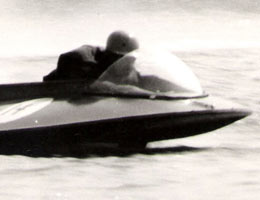 |
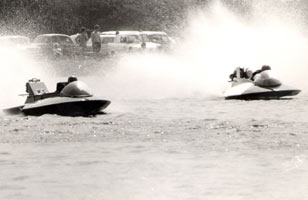 |
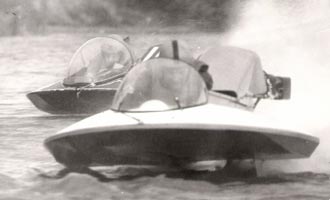 |
The twin was sold to Danny Keay and now resides with Jack Wood in Leeds. The Vee 4 was sold to John Skidmore who ran it for a while before destroying it comprehensively when a con rod broke. A new crankcase was built some years ago by ‘yours truly’ and now all the parts are in the hands of Peter Rix from Lowestoft who intends to restore it to running condition. Remarkably, it is the chrome bores that posed the biggest obstacle in the rebuilding of this fabulous motor.
Return to Tethered Racing
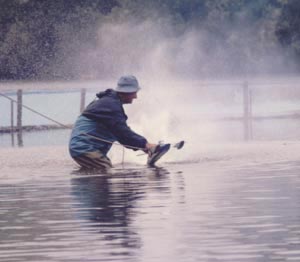 |
While the Bristol MES which had amalgamated with the Bristol Boat Club and Model Car Club was still going strong, celebrating its centenary in 2009, the Cotswold Model Marine Club was becoming the hotbed of tethered hydros in the area. John would eventually be elected Commodore of the Cotswold Club as well as a Vice President of the Model Hydroplane Club. Alongside John there was Jim Williams, another fine engineer, and between them they formed a formidable team for many years to come. On his return to the tethered hydroplane fraternity it is obvious that John had been busy in the workshop in the intervening period, as he had produced an exceptionally well engineered schnuerle ported 15cc engine for the ‘B’ class. Like his larger hydroplane engines, everything for the motor, including the castings were produced at home, and Mike Rose still remembers the Sundays when his mother wanted to start the dinner but had to wait as the moulds were being dried in the oven. He also had another project on the go as he had built an exact replica of his original 15cc four-stroke ‘Meteor’ to run in the vintage class. |
By 1979 John was competing regularly and beginning to get his boat and engine sorted. At the International that year he finished second to Ian Berne in the Miniature Speed Trophy with a run at 57.06mph.
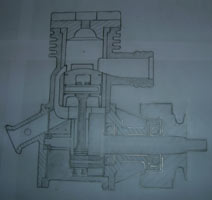 |
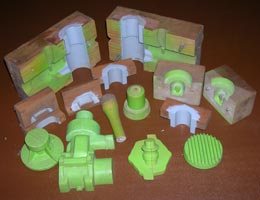 |
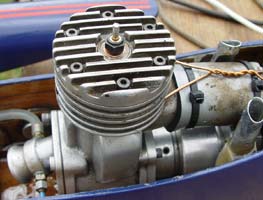 |
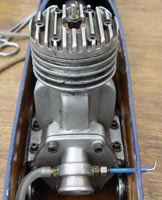 |
|
Mike still has the
original drawings and as you can see from the pictures is still in
possession of the patterns. |
|||
Run concurrently, either at area championships or the International are the Collier Cup and Mears Trophy for a run of 1000yds. John, and later his son Mike, were almost to make these trophies their personal property.
|
It was the following season where John was to come to real prominence with a comment in Model Boats recalling the likes of George Noble. "In recent times West Country expertise has begun to show itself again by the efforts of John Rose of the Cotswold Club". At the International in 1980, he broke the long-standing ‘B’ Class record of Dr Daly with runs of 78.7 for 500 yds and 79.05 for the 1000yds. What is even more remarkable is that from 1980 until the present day, nigh on 30 years, no one other than John Rose has broken the 15cc record. |
|
In 1981 John was awarded the prestigious Windermere Trophy for adding nearly 8mph to his existing record with a run of 86.04mph at his home water, South Cerney. Away from the water 1982 would see the family celebrating the wedding of Mike Rose to Karen Atwill. By the early 80s, the number of competitors running the 15cc home built engines was diminishing and while Jim Williams could never quite match the top speeds that John was producing, he was never far behind and would often pick up wins when John was not competing or not quite up to his best. The two of them also started to look seriously at the 10cc Class and for the 83 season, both had joined the ranks of A3 competitors. With the arrival of NAVIGA classes the 'C' and 'C/Restricted' classes had ceased to exist as such, so rather than a homebuilt motor, John had opted for an Italian commercial engine, as they were the ones ruling the roost in that class. While the OPS was making the running, John chose to go with a PICCO. Designed primarily for tethered cars, the motor was not sufficiently tractable for boat work so John modified the porting with a new stepped piston to give a less aggressive exhaust timing.
|
Running in three classes was not easy, but through constant development and detailed preparation, the 15 was running regularly at record speeds and the A3 boat was often in contention at regattas. In 1984 The ‘B’ Class record was broken again at 94.8mph, putting it over 90 for the first time. The regatta wins and trophies kept mounting up with the Speed Trophy and Collier Cup being almost permanent fixtures on the mantelpiece. John added the Windermere Trophy to the silverware again in 1986, with another new record of 98.2mph, set at Cerney on the 21st of September. |
|
In 1987, Peter Hill wrote in Model Boats that “He would like to make special reference to John Rose, who brought three boats to the International, giving six starts, six speeds, and each boat took first place in its allotted class, the first time this has ever been achieved. This was due to the fact that John is not only a very good engineer and has long experience of both full size and model hydroplanes, but his boats are always immaculate in design, finish and preparation; a lesson not only to hydroplanists but to all that run power boats”. This followed a clean sweep at the International where John won the ‘B’ Class at 95.6mph, A3 at 116mph with the PICCO and the Vintage class at 65.78mph with ‘Meteor’, which would also win him the Lambert Trophy for the first time.
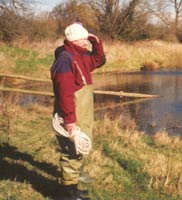 |
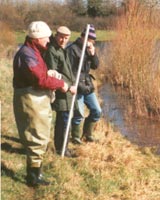 |
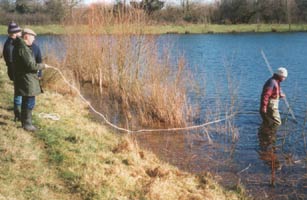 |
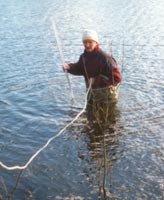 |
| John being despatched to find out the depth of the new lake at Cerney! | |||
John's younger son Mike was now becoming equally involved with racing tethered hydroplanes with the arrival of the ‘Novice’ class, which prompted him to join his dad in the sport. Mike was soon to make his mark as well, adding his name to the record books with his Novice class boats. Mike and Karen also presented John and Marion Rose with a grandson Antony in 1987, to be followed by a granddaughter Kayleigh in 1989. Antony has embraced tethered hydroplanes most enthusiastically, while Kayleigh's views on the sport are less clear.
|
During the 88 season John achieved his personal best with the A3 at 117.3mph, but in a ‘very rare off day’ at the International, damaged the 15cc motor and took no further part in the competition. With the engine rebuilt, the 1990 season was to produce another ‘unique happening’ when in September he beat his existing ‘B’ record with a run at 109.00mph, added a win in A3 with another personal best at 124.48mph and won the Lambert Trophy for the second time with the four-stroke ‘Meteor’ replica. Right: In foreground is the 'Meteor' replica taken in 1990 |
|
|
|
An added element was son Mike upping the novice record to 92.70mph. A remarkable personal and family achievement. Photographic evidence would suggest that John was building a trio of new hulls for the new season, all of similar design. One would be for the 15cc motor, another for the PICCO 10cc motor and the third for an OPS that he was also using in the 10cc class. Left: From 1991 is this photo of John, Antony and Mike, taken at South Cerney. |
The wins with the new boats continued through the following seasons until the 22nd of May 94 at Kingfisher, where John put in a run of 110.42mph in round one to set a new record and the first run over 110 by a 15cc boat. In round two the boat went even quicker to set yet another new record, and by quite a margin, with a speed of 115.91mph. This record still stands today, 15 years on!
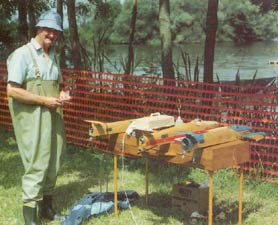 |
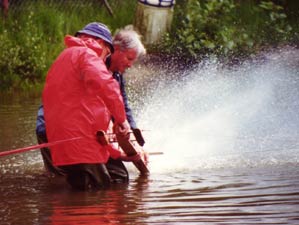 |
|
| Cerney in 1991 with the newly built hulls. | John Assisted by Jim Williams | Watching a run at St Albans |
In Sept 92 a large contingent from the UK
travelled to Amiens, France for an International regatta.
Jim Free provides this panel of photos of John Rose at that
meeting.
|
|
|
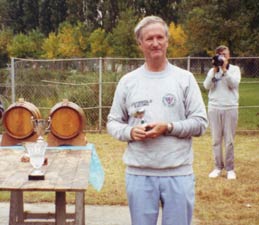 |
|
John Whelan, Jim Williams and John Rose of the
Cotswold Club with Jacques Perrier
of the host club. John preparing to put his A3 OPS on the line, launching and collecting 3rd in A3 at 118.34mph. |
||
Throughout the 1980s, Bob Kirtley had been working tirelessly on developing his ‘A’ Class flash steamer, upping the class record regularly. In 1988 Ian Berne joined the fray, and from then on the pair of them pushed the record up, almost on a run by run basis at times. By the end of 1989 the magic 100 mph had been well and truly smashed which persuaded Stan Poyser to have another go with a flash steamer. This competition carried on through the 90s, which obviously appealed to John who set about building himself a flash steam outfit. While the ‘A’ Class record was regularly being broken, the ‘B’ Class mark had stood for years, until Stan Poyser turned his attentions to the smaller class. With the weight constraints the 'B' class presented a very challenging design and engineering exercise, which John took on enthusiastically with this superbly engineered, single cylinder flash steam engine that he started building in 1995.
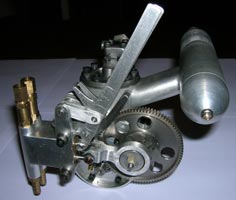 |
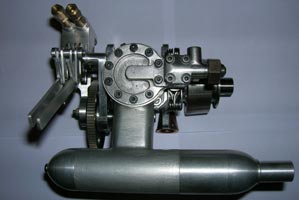 |
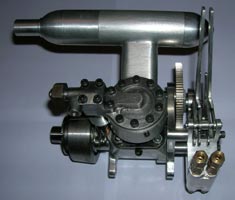 |
| Poppet valve, hairpin valve springs, adjustable throw pump eccentric and uniquely, twin rams on fuel and water pump. | ||
As well as continuing to work on the flash steamer, the 95 and 96 seasons produced the usual crop of race wins and trophies for John, including the Miniature Speed and Collier double at the International each year.
Unfortunately 1996 would be the last season that would
see John Rose competing around the country and dominating ‘B’ Class racing. The
steam project would also remain unfinished, as John
was taken seriously ill during the winter and after a six month battle with
cancer, died on the 19th of June 1997.
|
|
Long time friend, fellow Cotswold Club member and President of the Model Hydroplane Club, Jim Williams wrote, "His achievements gained in running his ‘B’ Class hydroplanes had not been equalled or surpassed to this day". Amazingly, this statement is still true 12 years on, which is a true measure of the skill and commitment of John Rose. Left: John and Jim Williams celebrate at Cerney |
The ‘Rose’ Legacy
|
Just 10 days after the death of his father, Mike Rose attended the Cotswold Club meeting with a view to running his late father’s 15cc boat. During the winter John had made further modifications and it was these and a box of props that faced Mike on this first outing. With help from Dave Whelan, Mike did get the boat going but did not record any official times. At the Southern Area Championships at Farnborough in July Mike managed 68 in the first round, but a second round speed of 95.68mph would give him his first of many wins with his late father’s boat. Right: The 'Record Holder' |
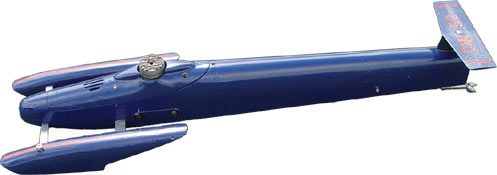 |
By Kingsbury in August, Mike had the boat back to its best with runs of 104 and 105mph to add the Midland Area Championship. Mike did not contest the ‘B’ Class at the International for that year, so for the first time for a long while, the miniature Speed Trophy and Collier Cup did not return to Bristol. While John DeMott won the class, no one completed the 1,000 yards to qualify for the Collier.
Mike loaned one of his father’s A3 boats, the OPS powered version, to fellow Cotswold members Dave and John Whelan, who took it over to Poitiers in France in September of that year for the International meeting. While the runs in the competition were most disappointing the final afternoon produced something of a highlight. The organisers had asked competitors to do some demonstration runs for the many visitors to the park and this time the speed was around 116mph.
|
Mike Rose started competing in his own right in 1988 and since 1997 has, along with his son Antony, competed regularly around the country, with their own boats, a selection of lovely vintage boats they have gathered together and of course John Rose’s remarkable stable, including the ‘B’ Class record holder in the later of the two hulls it was raced in. Having missed out on the International in 1987 Mike used the 15 to good effect the following year to win the Miniature Speed trophy for the first of many times in the following decade. Right: Mike ready to launch the 'record holder' at Rowden lake |
|
|
|
At Kingsbury in 1999 Mike's three runs with the boat at 103, 108, 103 mph showed just how reliable the motor was. At the International a stunning run of 111.18 was enough to secure the Speed Trophy for the second time, as well as the Collier, repeating the double that his late father had achieved on numerous occasions. This is the closest to date that Mike has come to the existing record with the boat.
Model Boats reported in 2001 that Mike had 'retrieved the 15cc record
holder from the loft for the June meeting at Cerney'. The first run at
102mph was encouraging, but in the second run the motor nipped up, so it
was back to the workshop for some remedial attention. |
With the engine rebuilt it was back to normal at Old Ford in July with two runs at over 100mph. Mike followed this up with speeds of 107 and 105mph back at Farnborough in September, reflecting the performance that he has managed to maintain for the rest of the decade with the remarkable engine. The Lambert Vintage Trophy resided in the Rose household for five consecutive years from 1998 to 2003 with three wins for Antony and two for Mike, while Mike has been a record holder on numerous occasions with his novice boat. Water conditions at the 2004 International at St Albans were far from good, yet Mike achieved the Speed Trophy/Collier double yet again. The year was to end on a sad note for the family though, with the sudden death of Marion Rose, just seven years after losing her husband.
|
The surviving boats are now the only tangible connection with the late John Rose. The ‘B’ Class boat still has the fastest 15cc homebuilt motor in the country, which is remarkable as it is now just on 30 years old. Considering the age and racing career of the boat, it would have been very tempting to put it into honourable retirement, but Mike took time out to restore it and its two stable mates. Seeing these boats run is a wonderful reminder of the skills and achievements of 'The West Country Wizard'. Right: Karen and Mike combining a holiday and regatta at Althorne |
|
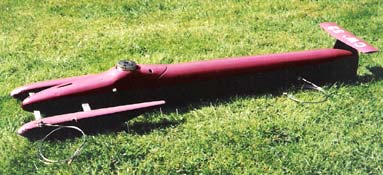 |
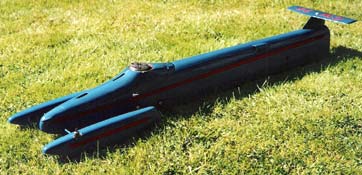 |
| 10cc powered by a gold top OPS 60, best speed 122 mph | 10cc powered by a Picco 60 |
When first built, the PICCO was the fastest boat of that
year at just over 125mph. This is Mike's current A3 boat, but he is not sure
when he will find the time to run it.
|
|
Whilst shortage of time has prevented him running the 10cc boats, the 15 gets a full season of racing each year and is not spared. It keeps up the tradition of doing the Speed Trophy/Collier Cup double at the International with some regularity, as well as continuing to dominate ‘B’ Class events at other regattas around the country. Left: Mike does the Collier/Miniature
Speed double again in 2009 |
|
|
The Collections.
Photo's and annotation by courtesy of Mike Rose Vintage 15cc 15cc Kiwi four stroke built by dad around 1948 to 1950. The hull was built in 1978 when dad returned back to the model hydro scene. This boat was capable of around 70 mph.
|
|
|
|
'KIWI' KIWI was built in 1947, the engine by George Kington and the boat by Jim Williams both members of the Bristol Model Engineers Society. This was their first attempt at hydros. I run this boat every year and runs at a steady 43 mph. The original engine was without a silencer so to comply with present regulations Jim fitted one.
|
|
30cc Vintage The engine is 30cc built by George Noble but I am not sure of its age. The hull is a Orthon replica built by Jim Williams. I run this boat at St Albans on the Saturday or when the water is rough as it runs on any condition of water. Best speed achieved is around 55 mph.
|
|
|
|
'Mr Jones' as can be seen by the design was built by Doc English, originally for use by his young neighbour, John Doughty, and is powered by an ETA 29. Cindy, Docs wife, found this boat in the loft after Docs death and gave in to Antony as a play toy when he was young. Antony restored it and we have run it a several regattas, usually St Albans on the Saturday. The boat is named after Jimmy Jones who was the commodore or the Birkenhead club. We have been able to record a very respectful speed of 75 mph . |
|
Vintage 10cc 10 cc Westbury Ensign design built around about 1955 by dad. Have never been able to get this engine to run but was told that it was capable of around 50 mph. Engine has now been replaced with a Merco 61 and is ready to run this year. Have never seen this boat run so should be interesting. When we know that the boat is OK then we may return to the original engine. |
|
We are indebted to Mike and Karen Rose and Antony for all their help in producing this article and for all the original photographs and annotation. Thanks go also to Jim Free and Terry Everitt for additional photographs
©copyrightMikeRose&OTW2009